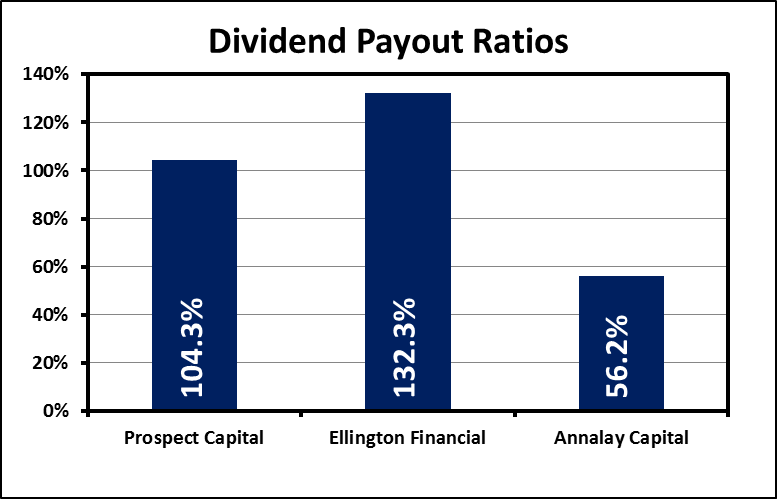The current average dividend yield of the Dow Jones 30 is about 2.7%, with telecom companies AT&T and Verizon leading the pack with yields of 4.4% and 5.3% respectively. While these yields can certainly be nice profit-generators for a portfolio, they pale in comparison to the yields of business development companies, such as Prospect Capital Corporation (NASDAQ: PSEC), master limited partnerships, such as Ellington Financial LLC (NYSE: EFC), and real estate investment trusts, such as Annalay Capital Management, Inc. (NYSE: NLY).
If you’ve ever run a stock screen looking for stocks with high dividend yields, you’ve probably had some of these companies turn up in your results.
Those yields almost seem too good to be true! In fact, as I have discussed before, one important way to assess the ability of a company to pay (or continue to pay) its dividend is by looking at a number called the payout ratio. The payout ratio is simply the dividend per share divided by the earnings per share. This number gives a quick indication of how much of a company’s profits are being immediately paid out to shareholders. Payout ratios for healthy companies usually do not exceed 50%.
All three of these companies’ payout ratios are well over 50%, and two of them are over 100%! So what the heck is going on here?
The answer to that question is that each of these three entities is a special type of company with special rules about how it distributes cash to its shareholders.
The Business Development Company
Prospect Capital, with its 12.8% yield and 104% payout ratio, is a type of company called a business development company (BDC). BDCs are essentially venture capital funds that trade on a public exchange. BDCs provide loans to smaller businesses, often in exchange for equity positions in the companies. For example, Prospect Capital recently announced that it invested $92 million into aircraft leasing company Echelon Aviation, a company in which Prospect is the controlling shareholder. BDCs hope that investments in smaller companies in need of capital will eventually pay off in the form of capital gains.
By law, BDCs must distribute 90% of their taxable income to shareholders, which is the reason Prospect’s payout ratio is so high. The downside to these huge payouts is that BDCs cannot rely on earnings to fund their investments and must instead turn to stock offerings or borrowing. Any savvy investor knows that stock offerings and debt are not good for share price, but share price growth is not what interests many BDC investors. All they care about is that gorgeous yield, which itself is not exactly a pure “dividend,” but rather a “distribution.”
The distinction between a typical dividend and a BDC distribution is the tax that shareholders pay. Typical dividends are taxed at capital gains tax rates, but BDC distributions may be subject to either capital gains rates or ordinary income tax rates depending on the source of the BDC’s income.
The Master Limited Partnership
Ellington Financial is a type of company called a master limited partnership (MLP). By law, an MLP must generate at least 90% of its income from “qualifying sources,” such as oil and natural gas exploration or real estate. Ellington Financial, for example, invests in residential mortgage-backed securities.
Like BDCs, MLPs do not pay typical corporate tax on their income. In that sense, “unitholders” (the MLP’s version of shareholders) are responsible for paying income or capital gains tax on their distributions. A large percentage of each distribution can be tax-differed and is simply subtracted from the cost basis of your “units” (shares). Again, since a great portion of the partnership’s income is distributed to shareholders, additional asset purchase are typically funded by issuing more units.
Real Estate Investment Trusts
Finally, Annalay Capital is a type of company called a real estate investment trust (REIT). REITs invest only in real estate. By paying out 90% or more of their earnings to shareholders, REITs are exempt from U.S. Federal income tax. Much like BDCs allow small individual investors access to the venture capital business, REITs allow access to real estate investment. Equity REITs own physical properties such as apartments or shopping centers, while mortgage REITs simply own mortgages. For example, as a mortgage REIT, 94% of Annalay’s portfolio consists of government-backed collateralized mortgage obligations.
As was the case with MLPs and BDCs, most of a REITs distributions are taxed as income rather than capital gains. In addition, asset purchases are often funded by share offerings.
Are these high yielders right for you?
The tickers of these three types of unique entities might scroll across your screen disguised as typical stocks, but they are entirely different beasts. The huge yields of these companies are certainly appealing. In addition, under the right circumstances ownership can provide valuable tax benefits. However, before you buy any of these companies for yourself, make sure you fully understand exactly what you are buying and the nuanced tax provisions associated with owning it in your portfolio.
Want to learn more about how to analyze stocks? Or maybe you just want to be able to look sophisticated in front of your coworkers when they ask you what you are reading on your Kindle, and you’d prefer to tell them “Oh, I’m just reading a book about stock market analysis,” rather than the usual “Oh, I’m just looking at pics of my ex-girlfriend on Facebook.” For these reasons and more, check out my book, Beating Wall Street with Common Sense. I don’t have a degree in finance; I have a degree in neuroscience. You don’t have to predict what stocks will do if you can predict what traders will do and be one step ahead of them. I made a 400% return in the stock market over five years using only basic principles of psychology and common sense. Beating Wall Street with Common Sense is now available on Amazon, and tradingcommonsense.com is always available on your local internet!



